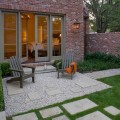Formal Garden Plans
Formal garden plans are always drafted with relationships in mind. Geometry and scale pay tribute to the architecture of the home and introduce powerful thematic overtones that affect the development of the entire surrounding landscape. Key features of formal design include central paths (and in some styles, bisecting paths) that allow visitors to walk through the garden, central focal points, seating in or near the garden, and external vantage points from which the garden may be viewed as a whole.
It is essential that you invest in a professionally designed formal garden plan. Without professional advice and planning, do-it-yourselfers invariably make the mistake of planting too many different types of plants in their garden. This results in overkill and overwhelms the senses.
What you want instead is a clearly recognizable geometric pattern that is defined by straight lines, sharp angles, and repeating patterns of selectively chosen hedges, flowering plants, shrubs, and low-growth trees. This creates order and system with an emphasis on content quality versus quantity.
A formal garden plan is developed by first determining the best vantage point from which it will be viewed. If the garden will be viewed from inside the home, then it is usually installed near a large window that offers a sweeping view of the Houston landscape. If the vantage point is external to the house, then the garden must be built in relationship to a patio, arbor, outdoor kitchen, or pergola that would function as a congregation point for guests who would look out over the garden.
Once location is determined, landscape developers then have to take some practical considerations into account. The ideal location may be under a canopy of tree limbs that blocks the majority of the sunlight. In such a case, shade resistant vegetation will have to be planted to maintain the vitality of the garden in spite of the lack of sunlight.
The grade of the land may also need to be changed in subtle ways to allow for hidden irrigation and drainage systems to be installed. If is included in the formal garden plan, decisions will need to be made early on as to whether or not these will be permanent benches or mobile outdoor furniture.
Working with a professional landscaper offers you the advantage of keeping your own personal intentions at the forefront of the planning process. While many people often think of the garden as something pretty to look at, a formal garden has historically been used as a landscape keynote or a gathering place for events. Pathways and seats are there for a reason—they give people a place to walk and relax in a setting rich in organic presence.
Your own affinity for a particular culture, such as the French, Italian, or Japanese, should also be discussed with your landscaping expert. If you have a love for history or have bought a home with a certain type of architecture that you like, this should factor heavily into choosing the type of type of garden you ultimately have installed on your property.
When you work with a team like ours that personal tastes a priority to our team, you wind up at the end of the day with a formal garden plan that is not only impeccably true to its intended form, but highly personalized to your own individual lifestyle, preferences, and value system.

